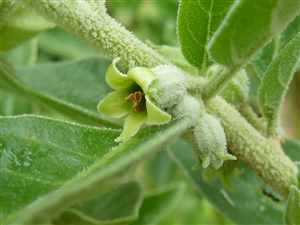Ashwagandha (Withania somnifera)
Main Facts about Ashwagandha

Using Ashwagandha
Ashwagandha, an excellent source of antioxidants, is considered an adaptogenic herb, meaning that it increases the body's overall resistance and helps to normalise bodily functions without stimulation burnout. It is famous for improving the body's responses to stress and boosting physical endurance. Great for exhaustion from physical and mental strain, stress-related ulcers, nervous exhaustion, depression. Helps boost thyroid hormone and adrenals to prevent stress-caused thyroid burnout. Studies also show that it enhances memorisation and concentration ability over prolonged periods and is effective for cardiac problems caused or aggravated by stress. Ashwagandha both stimulates and protects the immune system. It also helps hormonal balance and reduces menopausal symptoms (mood swings, hot flashes) Popular aphrodisiac. The Kama Sutra mentions ashwagandha as a potent sexual stimulant. Research indicates that the herb supports sexual health and vitality by increasing blood flow and reducing bodily tension. According to preliminary studies Ashwagandha reduces tumor cell proliferation while increasing overall animal survival time; enhances the effectiveness of radiation therapy while potentially mitigating undesirable side effects; also reduces the side effects of chemotherapeutic agents without interfering with the tumor-reducing actions of the drugs. These effects have been demonstrated in vitro on human cancer cell lines and in vivo on animal subjects but there have been no human trials to date. The whole plant is useable. In Ayurveda, the berries and leaves are applied externally to tumors, tubercular glands, carbuncles, and ulcers. Roots are used to make famous medicinal powder. It is recommended to balance one month of treatment - one week of rest - one other month of treatment. Is often sold in capsules. If taken as a decoction, it is not recommended to take more than 2 cups per day.Ashwagandha is a remedy for: Cold and flu, Anxiety, Arthritis
Caution!
Toxicity studies reveal that ashwagandha appears to be a safe compound. Do not use if pregnant or breastfeeding.Cooking with Ashwagandha
In order to extract all the active ingredients, boil the plant for 15 min, then leave it to infuse for 10 min. The berries can be used as a substitute for rennet in cheesemaking.How to grow Ashwagandha
Cultivated in many of the drier regions of India, is also found in Nepal.| Arnica |
Asparagus
|